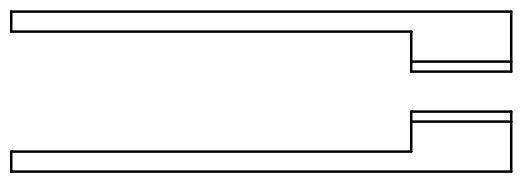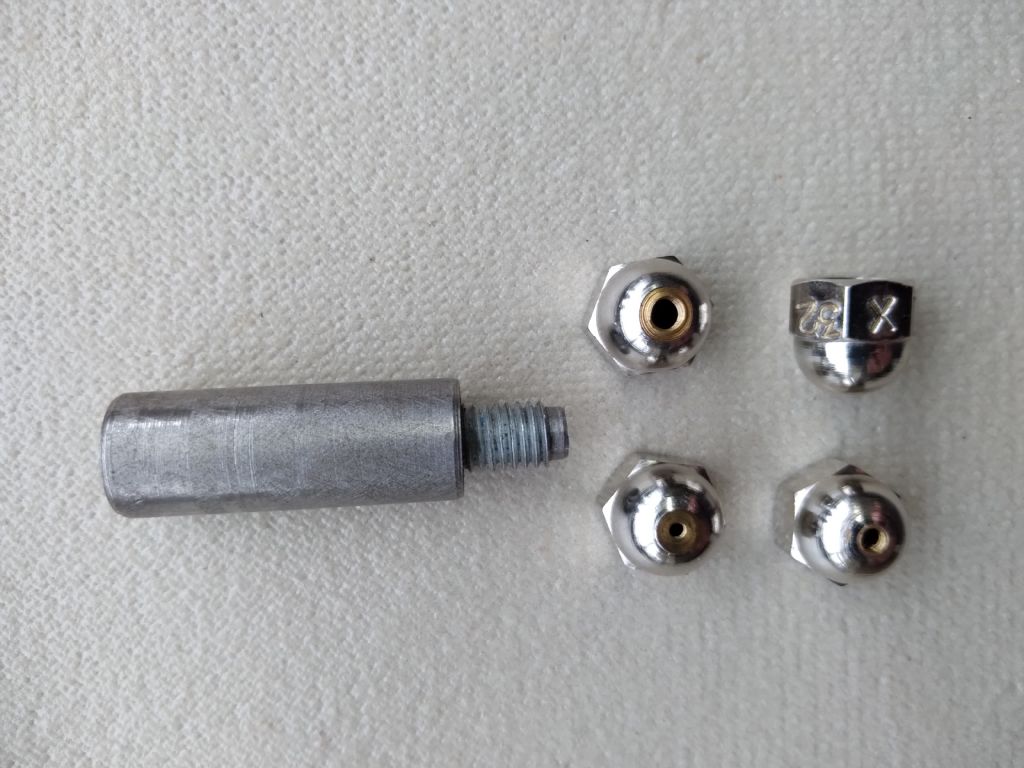Shortening Screws
| Vic | 13/12/2021 10:48:37 |
| 3453 forum posts 23 photos | What method do you use? I ask as I’ve recently seen a Lantern Chuck again. I’ve never used or much like the idea of a screw plate. I prefer using the lathe. I currently use some little plugs tapped to size and held in a collet Chuck. I just wondered what other methods folks use? |
| Juddy | 13/12/2021 10:57:12 |
131 forum posts | Junior hacksaw normally, dependent on the screw size, screw a nut onto the thread first then cut and file unscrew the nut which will clean the odd deformed thread at the end of the screw. Larger bolts, lock two nuts on the bolt cut off the unwanted portion with a hacksaw in the vice, clean up the end in the lathe or file. |
| Nigel Graham 2 | 13/12/2021 11:25:32 |
| 3293 forum posts 112 photos | If you want a turned end, short of making a lantern-chuck: The screw-collet of course should be longer than the lathe collet or chuck-jaws. For screws finishing longer than the chuck jaws or collet depth, use a simple threaded collet in front of a spindle back-stop that bears on the screw-head. If the finished screw will be shorter than the lathe collet or chuck, you could use a longer threaded collet whose back end is counter-drilled to clear the head, then tapped for a locking-screw that contacts the screw-head. Use a brass locking-screw, or a steel screw with brass or plastic slug, to avoid damage to the workpiece head. |
| Thor 🇳🇴 | 13/12/2021 11:29:23 |
1766 forum posts 46 photos | I use my home-made Lantern chuck, works well and I can clean up the thread using a tailstock die-holder. Thor |
| Henry Brown | 13/12/2021 11:51:17 |
618 forum posts 122 photos | Very nice Thor, printed off ready to make! I usually use the nut and junior hacksaw for small screws and bolts, I find large ones aren't so much of a problem... |
| martin haysom | 13/12/2021 11:57:08 |
165 forum posts | used hacksaw and file for years but not anymore as i made the lantern chuck in MEW Edited By martin haysom on 13/12/2021 11:58:01 |
| Vic | 13/12/2021 13:35:03 |
| 3453 forum posts 23 photos | Posted by Thor 🇳🇴 on 13/12/2021 11:29:23:
I use my home-made Lantern chuck, works well and I can clean up the thread using a tailstock die-holder. Thor Thanks for that Thor. It’s a much simpler design than others I’ve seen so I may make something similar. |
| Bill Phinn | 13/12/2021 15:01:33 |
| 1076 forum posts 129 photos | For common thread sizes I use tapped lengths of square and hex bar held in the milling vice I have fixed at right angles to my jig-mounted 5-inch angle grinder. The screw to be shortened is held captive inside the bar with a hex nut, which acts as both a guide/stop for where the cut is to be made and as a heat sink to reduce the chance of the screw being overheated during the cut. It's a quick and accurate method requiring no lathe or special chuck. |
| Phil H1 | 13/12/2021 15:08:05 |
| 467 forum posts 60 photos | Simple spacer, junior hacksaw, chuck the hex head screw in my hand drill gripped by the hex head, file and emery. |
| Mick B1 | 13/12/2021 15:23:56 |
| 2444 forum posts 139 photos | Tapped bit of hex brass (A/F > head size of course) slit lengthwise with junior hacksaw. Make sure the slit is between jaws on the 3-jaw, and clamp tight. Part off or face the length - light cutting forces, don't be greedy. |
| Martin Kyte | 13/12/2021 15:45:30 |
3445 forum posts 62 photos | Jewelers piercing saw is the way to go for smaller sizes, no burr to speak of and looks quite tidy. regards Martin |
| jacques maurel | 13/12/2021 17:17:03 |
84 forum posts 20 photos | Have a look at this article: Model Engineer- N° 4480 (apr 2014) : Threaded collets regards J M |
| Macolm | 13/12/2021 17:31:10 |
185 forum posts 33 photos | If your lathe can be used in reverse, mounting the screw from inside a threaded sleeve allows the excess to be parted off. I have an interal grooving tool that works for this. I just hold it in a three jaw chuck, which is adequate for most purposes. Edited By Macolm on 13/12/2021 17:33:33 Edited By Macolm on 13/12/2021 17:34:17 |
| Nimble | 13/12/2021 20:25:51 |
66 forum posts 6 photos |
One method of shortening screws is to screw on nut with excess length protruding, hold nut in vice and use a cold chisel to cut off excess length, unscrewing nut from screw will clean up thread. Alternatively a cheap and cheerful “lantern chuck” can be made by turning down a short length of rod and threading the end, then using dome nuts in the three jaw drill and tap to the require size (head of screw must be able to enter), position screw to give length of screw required. Screw nut onto threaded shaft until head hits end of threaded portion, place in chuck and turn off unwanted portion of screw. Disassemble to remove screw. I have done down to a 2mm screw.ic
|
| Howard Lewis | 14/12/2021 16:30:47 |
| 7227 forum posts 21 photos | My first attempt at a lantern chuck worked but not particularly well. The Johnn Ashton design that won the John Stevenson Trophy is a much better device. It took a time to make all the carriers, but time well m,spent, to have a tool that holds the screw solidly and prevents it bending or backing away under cutting loads. Howard |
Please login to post a reply.
Want the latest issue of Model Engineer or Model Engineers' Workshop? Use our magazine locator links to find your nearest stockist!
Sign up to our newsletter and get a free digital issue.
You can unsubscribe at anytime. View our privacy policy at www.mortons.co.uk/privacy
- *Oct 2023: FORUM MIGRATION TIMELINE*
05/10/2023 07:57:11 - Making ER11 collet chuck
05/10/2023 07:56:24 - What did you do today? 2023
05/10/2023 07:25:01 - Orrery
05/10/2023 06:00:41 - Wera hand-tools
05/10/2023 05:47:07 - New member
05/10/2023 04:40:11 - Problems with external pot on at1 vfd
05/10/2023 00:06:32 - Drain plug
04/10/2023 23:36:17 - digi phase converter for 10 machines.....
04/10/2023 23:13:48 - Winter Storage Of Locomotives
04/10/2023 21:02:11 - More Latest Posts...
- View All Topics
- Reeves** - Rebuilt Royal Scot by Martin Evans
by John Broughton
£300.00 - BRITANNIA 5" GAUGE James Perrier
by Jon Seabright 1
£2,500.00 - Drill Grinder - for restoration
by Nigel Graham 2
£0.00 - WARCO WM18 MILLING MACHINE
by Alex Chudley
£1,200.00 - MYFORD SUPER 7 LATHE
by Alex Chudley
£2,000.00 - More "For Sale" Ads...
- D1-3 backplate
by Michael Horley
Price Not Specified - fixed steady for a Colchester bantam mark1 800
by George Jervis
Price Not Specified - lbsc pansy
by JACK SIDEBOTHAM
Price Not Specified - Pratt Burnerd multifit chuck key.
by Tim Riome
Price Not Specified - BANDSAW BLADE WELDER
by HUGH
Price Not Specified - More "Wanted" Ads...
Do you want to contact the Model Engineer and Model Engineers' Workshop team?
You can contact us by phone, mail or email about the magazines including becoming a contributor, submitting reader's letters or making queries about articles. You can also get in touch about this website, advertising or other general issues.
Click THIS LINK for full contact details.
For subscription issues please see THIS LINK.
Model Engineer Magazine
- Percival Marshall
- M.E. History
- LittleLEC
- M.E. Clock
ME Workshop
- An Adcock
- & Shipley
- Horizontal
- Mill
Subscribe Now
- Great savings
- Delivered to your door
Pre-order your copy!
- Delivered to your doorstep!
- Free UK delivery!













 Register
Register Log-in
Log-in


